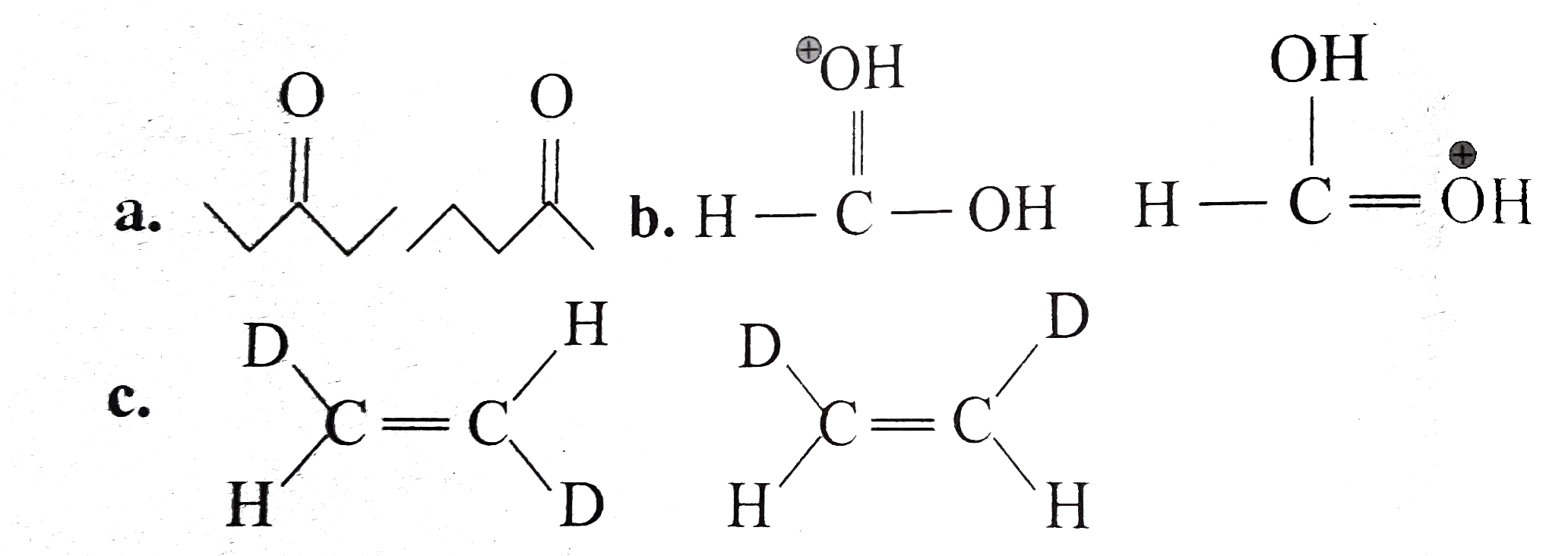What is the relationship between the members of following pairs of structures? Are they structural or geometrical isomers or resonance contributors?
H−+OH∣∣C−OH H−OH∣C+−OH
To determine the relationship between the given pairs of structures, we need to analyze their characteristics and see if they are structural isomers, geometrical isomers, or resonance contributors.
1. Identify the Structures:
- The first structure can be represented as:
H−+OH−C=O−H
- The second structure can be represented as:
H−OHC+−OH
2. Analyze the Structures:
- In the first structure, we have a carbon atom double-bonded to an oxygen atom (C=O) and single-bonded to a hydroxyl group (OH).
- The second structure has a carbon atom that carries a positive charge (C^+) and is bonded to two hydroxyl groups (OH).
3. Check for Resonance:
- To check if these structures are resonance contributors, we can see if one structure can be transformed into the other by the movement of electrons.
- If we shift the double bond from the carbon to the oxygen in the first structure, we can generate the second structure. This indicates that both structures are resonance forms of each other.
4. Evaluate Stability:
- In the first structure, the carbon atom has a complete octet (8 electrons), while in the second structure, the carbon atom has only 6 electrons around it, making it less stable.
- Resonance contributors with incomplete octets are generally less stable and contribute less to the resonance hybrid.
5. Conclusion:
- Since both structures can be interconverted by the movement of electrons and represent different forms of the same molecule, they are resonance contributors.
Final Answer:
The two structures are resonance contributors.
- The first structure can be represented as:
H−+OH−C=O−H
- The second structure can be represented as:
H−OHC+−OH
- In the first structure, we have a carbon atom double-bonded to an oxygen atom (C=O) and single-bonded to a hydroxyl group (OH).
- The second structure has a carbon atom that carries a positive charge (C^+) and is bonded to two hydroxyl groups (OH).
- To check if these structures are resonance contributors, we can see if one structure can be transformed into the other by the movement of electrons.
- If we shift the double bond from the carbon to the oxygen in the first structure, we can generate the second structure. This indicates that both structures are resonance forms of each other.
- In the first structure, the carbon atom has a complete octet (8 electrons), while in the second structure, the carbon atom has only 6 electrons around it, making it less stable.
- Resonance contributors with incomplete octets are generally less stable and contribute less to the resonance hybrid.
- Since both structures can be interconverted by the movement of electrons and represent different forms of the same molecule, they are resonance contributors.
The two structures are resonance contributors.
Topper's Solved these Questions
- BOOK - ICSECHAPTER - ORGANIC CHEMISTRY : SOME BASIC PRINCIPLES AND TECHNIQUES EXERCISE - ASSERTION - REASON TYPE QUESTIONS11videos
ORGANIC CHEMISTRY : SOME BASIC PRINCIPLES AND TECHNIQUES
- BOOK - ICSECHAPTER - HYDROGENEXERCISE - NCERT TEXT-BOOK EXERCISE (With Hints and Solutions)53videos
HYDROGEN
- BOOK - ICSECHAPTER - REDOX REACTIONS (OXIDATION AND REDUCTION)EXERCISE - NCERT TEXT-BOOK. EXERCISES ((With Hints and Solutions)69videos
REDOX REACTIONS (OXIDATION AND REDUCTION)
Similar Questions
Knowledge Check
- Question 1 - Select One
The IUPAC name ofCH3−OH∣C∣H−CH2−O∣∣C−CH3 is
A2-Hydroxypentan-4-oneB4-Hydroxypentan-2-oneC4-oxopentan-2-olD2-oxopentan-4-ol - Question 2 - Select One or More
H−O∣∣C−OH and H3C−O∣∣C−OH can be distinguished by:
ANaHCO3BH2SO4CAgNO3/NH4OHDFehling solution
The correct IUPAC name of the H−O∣∣C−O∣∣C−O∣∣C−OH is
View SolutionThe IUPAC name of
CH3−O∣∣C−CH2−OH∣CH−CHO
isView SolutionThe IUPAC name of
CH3−O∣∣C−CH2−OH∣CH−CHO
isView SolutionCH3−OH∣CH−O∣∣C−CH2−CH3 will respond to
View SolutionThe IUPAC name for CH3−C∣∣C−CH2−CH2−C∣∣C−OH is
View SolutionWhat is the relation between the following pairs ?
(a)
(c) H−+OH∣∣C−OH and H−OH∣C=+OHView Solution


 .
.